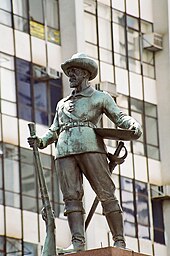Bartolomeu Bueno da Silva

Bartolomeu Bueno da Silva , known as Annexüera (* 1672 in Santana do Parnaíba , † September 19, 1740 in Goiás Velho ) was a Brazilian bandeirante from São Paulo , son of Francisco Bueno .
As early as 1682 he accompanied his father on the first Bandeira , which led from São Paulo north to the area of today's Goiás . During this time the rumor arose that the Serra dos Martírios was rich in gold and precious stones. The Bandeira did not come back with riches, but with so many captured locals who were sold as slaves that the family had a secure livelihood for the next few years.
In 1701, the gold finds Bartolomeu Bueno da Silva moved to Sabará , Minas Gerais , later to São José do Pará and Pitangui , where he was appointed tax collector of the district.
Because of the Guerra dos Emboabas , a civil war-like dispute in the vicinity of the gold mining areas, da Silva returned to Parnaíba (today's state of São Paulo).
He then decided to put together a new Bandeira to investigate the rumors about the mineral resources in Goiás and set out on June 30, 1722 on behalf of the governor Rodrigo Cesar de Menezes from São Paulo. His son-in-law, brother-in-law and two Benedictine monks accompanied him.
After three years of expedition full of privation, in constant struggle against the indigenous population , illness, but also the desertion of various companions, da Silva found again the places that he had discovered with his father 36 years ago. After finding gold in the Rio Vermelho , he returned to São Paulo in 1725 and set out again for Goiás a year later in May 1726 to exploit the mines that had been discovered.
In the same year he founded the place Arraial de Barra , today's Buenolândia not far from today's Goiás Velho, and as Capitão-mór regente of the mines had supreme judicial power in civil and criminal matters. In addition to the judiciary , da Silva received customs rights for the rivers Iguatibaya , Jaguari , Rio Grande , Rio Pardo , Rio das Velhas , Rio Parnaíba , Rio Guacurumbá , Rio Meia Ponte and Rio dos Pasmados .
However, all privileges were withdrawn from him a short time later by the new governor Antonio da Silva Caldeira . In recognition of his services to the development of the mineral resources in Goiás and the enormous wealth that these brought to the Portuguese crown, he was promised a part of the tax income, from which he would cover his retirement. This privilege was also cashed in, and so the last great bandeirante died in 1740 in Vila Boa de Goiás completely impoverished.
Appendices
Bueno da Silva took over the nickname "Appendixuera" from his father, whom he received from the local population. Legend has it that the father, attracted by the rich gold jewelry that the indigenous women in Goiás wore, called the chiefs together and asked them where the gold was found. When they refused to show them to him, he lit a bowl full of brandy and threatened that he would let all the lakes and rivers burn if they did not lead him to the gold, which they did immediately. From that day on, they called him “Appendixuera”, which means “Old Devil” in Tupí , the language of the local population.
Individual evidence
- ↑ São Franciscoin Portal
- ↑ To Governo de Engonços: Metrópole e Sertanistas na Expansão dos Domínios Portugueses aos Sertões do Cuiabá (1721-1728). In: www.academia.edu. Retrieved March 12, 2016 .
| personal data | |
|---|---|
| SURNAME | Bueno da Silva, Bartolomeu |
| ALTERNATIVE NAMES | Appendices |
| BRIEF DESCRIPTION | Brazilian bandeirante |
| DATE OF BIRTH | 1672 |
| PLACE OF BIRTH | Santana do Parnaíba |
| DATE OF DEATH | September 19, 1740 |
| Place of death | Goiás Velho |

